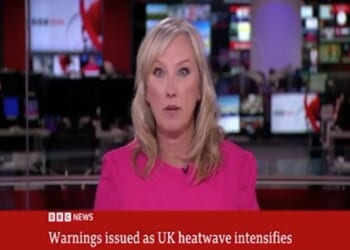Lord Ashcroft KCMG PC is an international businessman, philanthropist, author and pollster. For more information on his work, visit lordashcroft.com
My latest poll looks at the winter fuel reversal and Labour’s new approach to immigration, the two-child benefit cap, who presents the biggest threat to Labour and expectations for the next election, as well as our regular questions on the parties and leaders. We also ask what people think Rachel Reeves should – and will – do in this week’s spending review.
What have they noticed – and who has noticed what?
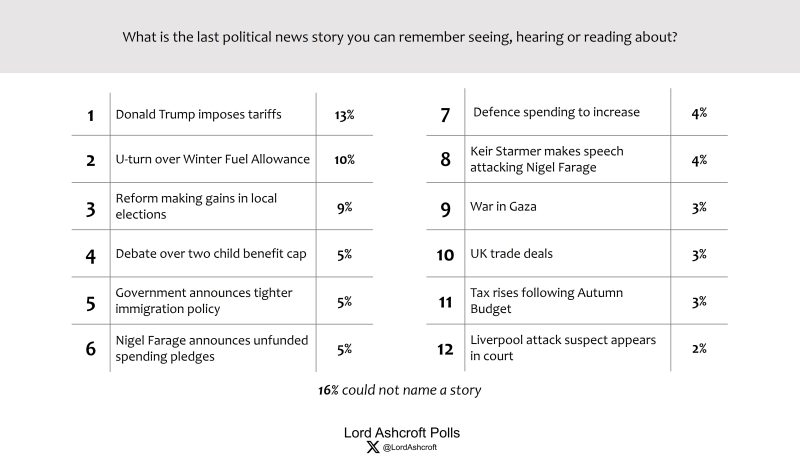
US tariffs were the most noticed political story, followed by the winter fuel allowance reversal and Reform’s gains in the local elections. The debate over the two-child benefit cap, the government’s tighter immigration policy and arguments over Nigel Farage’s economic plans also registered.
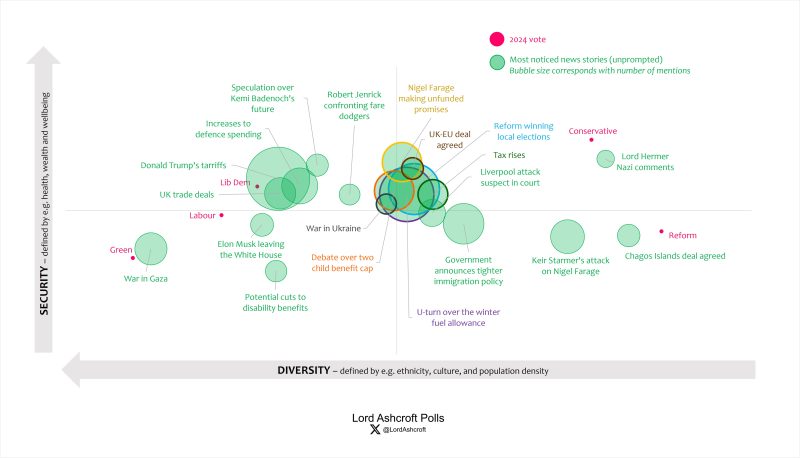
Our political map shows which stories were most likely to have been noticed by which kinds of voters. We can see that stories about the Chagos Islands deal, immigration and and Keir Starmer’s speech attacked Farage and Reform were most likely to have been noticed in the less well-off, less diverse, Reform-backing bottom-right quadrant, while Attorney General Lord Hermer’s comments comparing opponents to Nazis was most likely to have registered in the more prosperous, Conservative-leaning top right. Tariffs, trade deals and Tory leadership speculation were most noticed in the better-off, more diverse, liberal-leaning top-left quadrant, while Gaza and potential disability benefit cuts were most likely to be picked up in the more diverse, less well-off bottom left. Stories about Ukraine, the two-child benefit cap, local elections and the UK-EU reset appear close to the centre of the map, showing that they were registered to varying degrees across the board.
What have Labour done?
Each month we ask poll participants to name, unprompted, anything specific they can recall the Labour government doing since it was elected last July, whether they agreed with it or not.
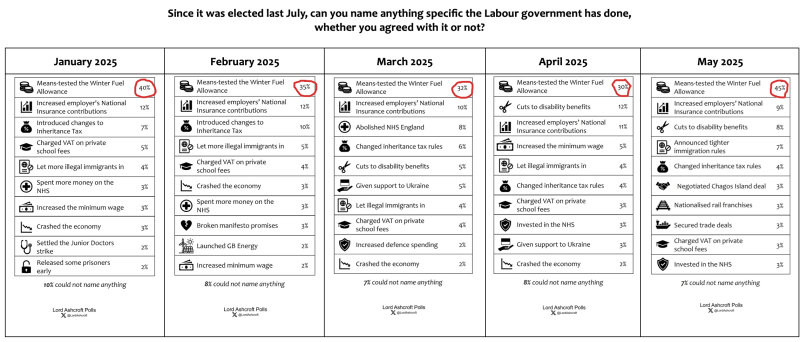
The winter fuel allowance has topped the list every month, though with a steadily declining number of mentions: 40 per cent named it in January, falling to 30 per cent in April. At the end of May, following the trailing of the U-turn, mentions rose to a record 45 per cent – five times as many as the next most mentioned action, the increase in employers’ National Insurance.
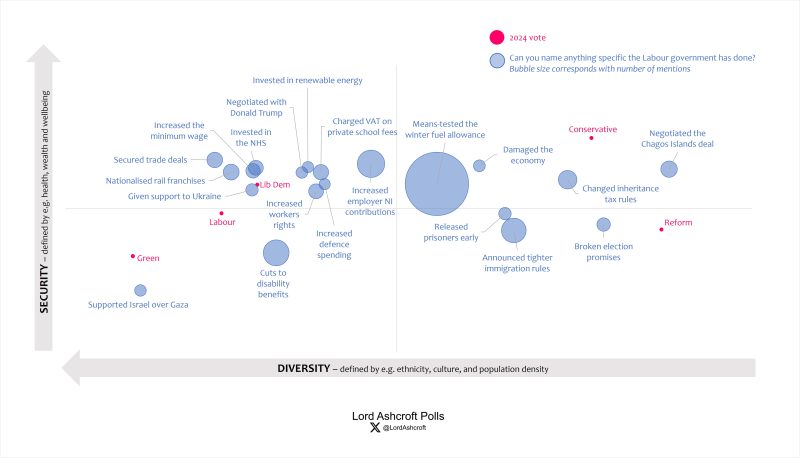 Again, our map shows which government actions were most likely to have been noticed by which kinds of voters. Winter fuel and National Insurance both appear close to the centre, meaning they were recalled fairly evenly throughout the electorate. Immigration, early prisoner releases and broken promises were most likely to be mentioned in the bottom right, inheritance tax and the Chagos Islands in the top right, Gaza and disability benefit cuts in the bottom left, and trade deal, nationalised rail franchises, NHS investment, renewable energy, workers’ rights, VAT on school fees, negotiations with Trump and higher defence spending in the top left.
Again, our map shows which government actions were most likely to have been noticed by which kinds of voters. Winter fuel and National Insurance both appear close to the centre, meaning they were recalled fairly evenly throughout the electorate. Immigration, early prisoner releases and broken promises were most likely to be mentioned in the bottom right, inheritance tax and the Chagos Islands in the top right, Gaza and disability benefit cuts in the bottom left, and trade deal, nationalised rail franchises, NHS investment, renewable energy, workers’ rights, VAT on school fees, negotiations with Trump and higher defence spending in the top left.
Winter fuel
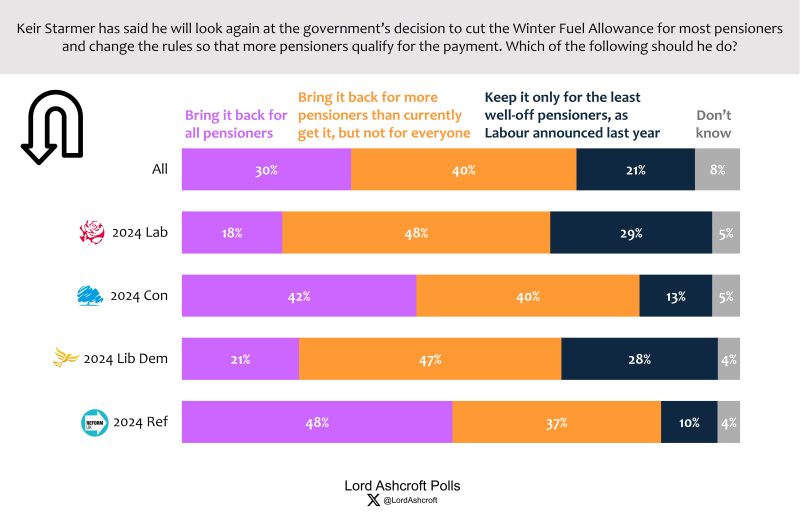
Ahead of the decision on which pensioners would have the winter fuel allowance reinstated, we asked whether it should be restored for all, for some, or kept only for the least well-off. Restoring the allowance for more pensioners but not for all of them was the most popular option, backed by 40 per cent, followed by bringing it back for all pensioners. 2024 Conservatives and Reform voters were the most likely to favour bringing the payment back for all pensioners, while Labour and Lib Dem voters were the most in favour of restoring it for some but not all. Labour and Lib Dem voters were also the most likely to favour keeping the allowance only for the least well-off pensioners, as announced by the government last year.
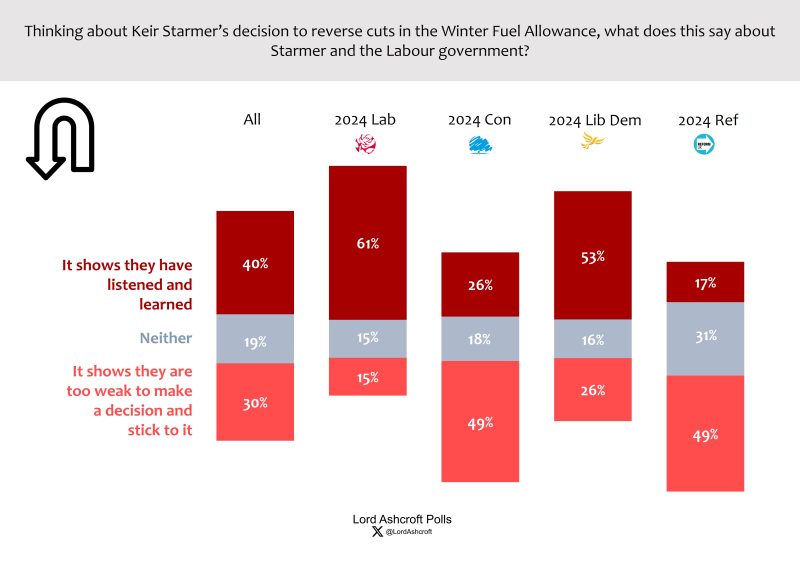
Four in ten voters (including 61 per cent of 2024 Labour voters) said the decision to reverse cuts in the winter fuel allowance showed that Starmer and the government had listened and learned. Three in ten (including one third of those who switched from the Conservatives to Labour last year, and 15 per cent of all 2024 Labour voters) said it showed that the Labour government was too weak to make a decision and stick to it.
Two-child benefits cap
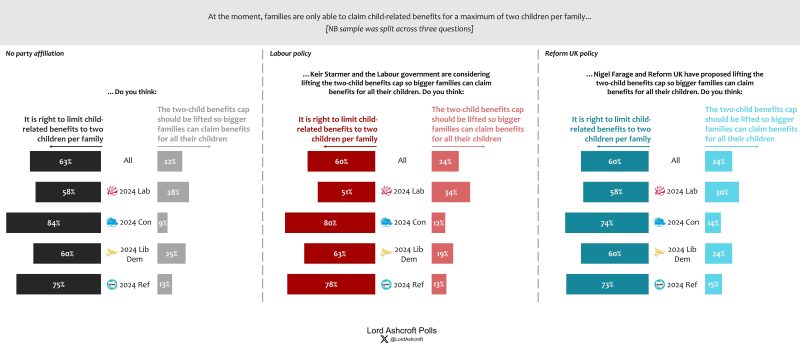
We asked one third of our sample whether they supported the two-child benefit cap; another third what they thought after being told Labour were considering lifting it; and another third what they thought after being told Reform UK wanted to lift it. The results were very similar in each case, suggesting people’s views of the issue are not strongly related to any party’s position on it: 63 per cent in the first group backed the cap with no further information, and 60 per cent backed it in both the second and third groups.
Fifty-eight per cent of 2024 Labour voters said it was right to keep the cap with no further information and knowing Reform were considering lifting it, but this fell to 51 per cent among those who were told Labour were considering lifting it. Among 2024 Reform voters, three quarters supported the cap with no further information, 78 per cent supported it when told Labour were considering lifting it, and 73 per cent still backed it when told Farage and Reform had proposed lifting it.
Spending Review
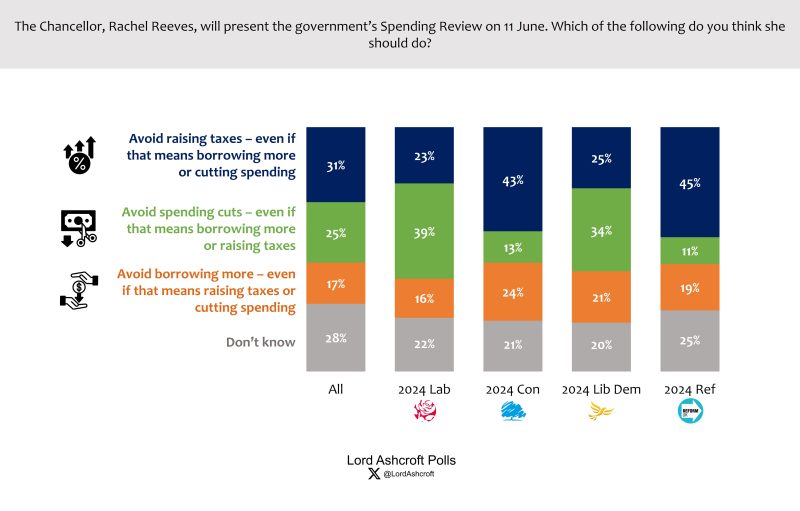 We asked voters what it was most important for Rachel Reeves to avoid in this week’s spending review: tax rises, spending cuts, or more borrowing. Voters as a whole thought it was more important for the Chancellor to avoid raising taxes (31 per cent) than to avoid spending cuts (25 per cent) or to avoid borrowing more (17 per cent). 2024 Conservatives and Reform voters thought it was more important to avoid tax rises and extra borrowing than spending cuts; 2024 Labour voters thought it was more important to avoid spending cuts than tax rises or extra borrowing.
We asked voters what it was most important for Rachel Reeves to avoid in this week’s spending review: tax rises, spending cuts, or more borrowing. Voters as a whole thought it was more important for the Chancellor to avoid raising taxes (31 per cent) than to avoid spending cuts (25 per cent) or to avoid borrowing more (17 per cent). 2024 Conservatives and Reform voters thought it was more important to avoid tax rises and extra borrowing than spending cuts; 2024 Labour voters thought it was more important to avoid spending cuts than tax rises or extra borrowing.
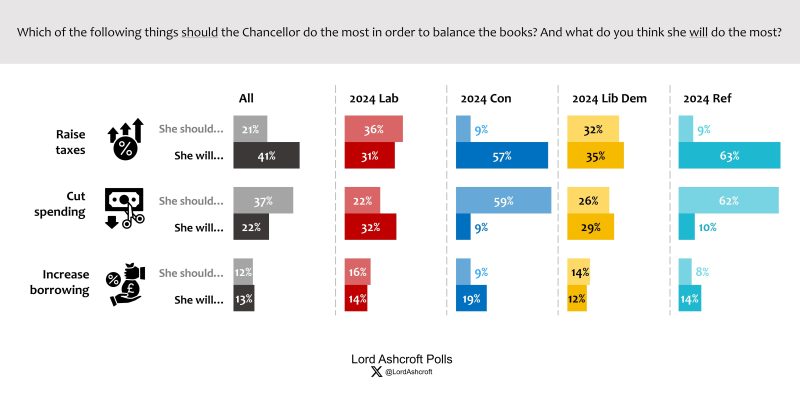 We also asked people what the Chancellor should do most in order to balance the books, and what they think she will do. Voters were nearly twice as likely to think Rachel Reeves will raise taxes (41 per cent) as to say she should do so (21 per cent). 2024 Labour voters were slightly more likely to say she should raise taxes than to think she would do so.
We also asked people what the Chancellor should do most in order to balance the books, and what they think she will do. Voters were nearly twice as likely to think Rachel Reeves will raise taxes (41 per cent) as to say she should do so (21 per cent). 2024 Labour voters were slightly more likely to say she should raise taxes than to think she would do so.
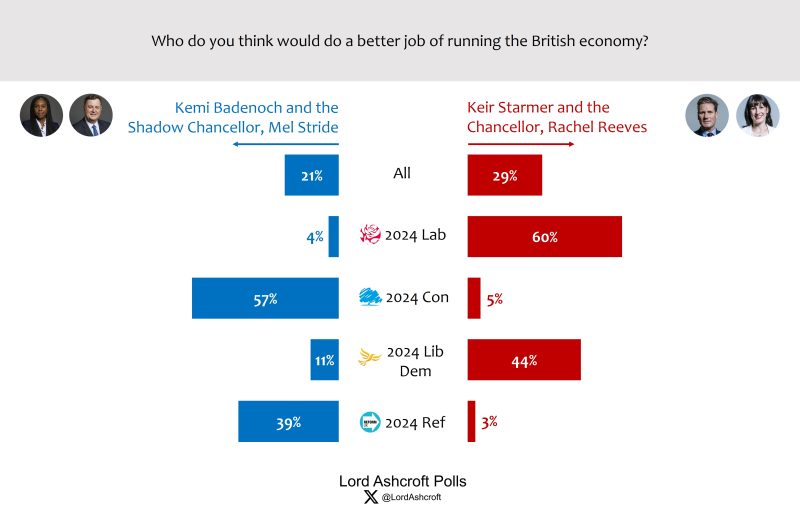 Asked who would do the better job running the economy, voters chose Starmer and Rachel Reeves over Badenoch and Mel Stride by 29 per cent to 21 per cent with half saying “don’t know”. Only six in ten 2024 Labour voters named the Labour team; 57 per cent of 2024 Conservatives chose the Tory team.
Asked who would do the better job running the economy, voters chose Starmer and Rachel Reeves over Badenoch and Mel Stride by 29 per cent to 21 per cent with half saying “don’t know”. Only six in ten 2024 Labour voters named the Labour team; 57 per cent of 2024 Conservatives chose the Tory team.
Immigration

Voters overwhelmingly believe Labour’s new policies on immigration are prompted by worries about losing votes to Reform and other parties, rather than because they think they are right for the country. 2024 Labour voters are nearly as likely to think this as the country as a whole. This strongly reflects the findings of our recent focus groups, in which sceptical voters doubted the sincerity of the change and some Labour voters worried that Starmer was too ready to “pander” to the right.
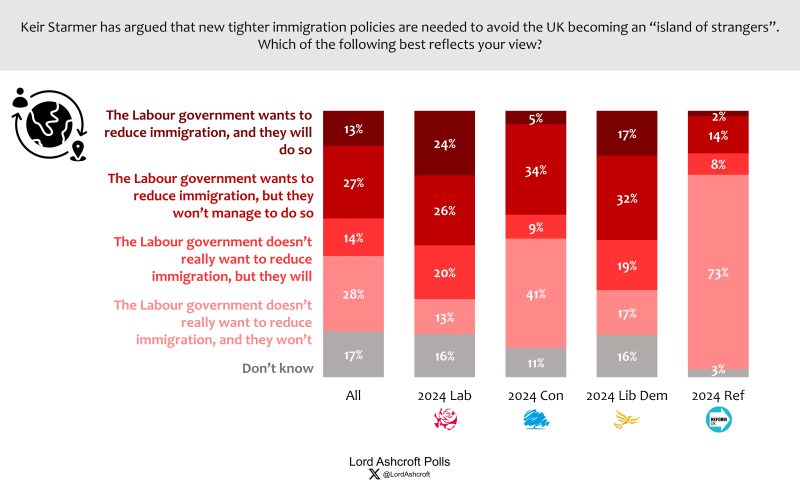 Only 13 per cent of voters (including fewer than a quarter of 2024 Labour voters) thought Labour both wanted to reduce immigration and would actually do so. More than twice as many thought that Labour didn’t really want to reduce immigration and wouldn’t do so. Overall, 40 per cent thought Labour wanted to reduce immigration (whether they would succeed or not), and 27 per cent thought they would reduce immigration (whether they really wanted to or not).
Only 13 per cent of voters (including fewer than a quarter of 2024 Labour voters) thought Labour both wanted to reduce immigration and would actually do so. More than twice as many thought that Labour didn’t really want to reduce immigration and wouldn’t do so. Overall, 40 per cent thought Labour wanted to reduce immigration (whether they would succeed or not), and 27 per cent thought they would reduce immigration (whether they really wanted to or not).
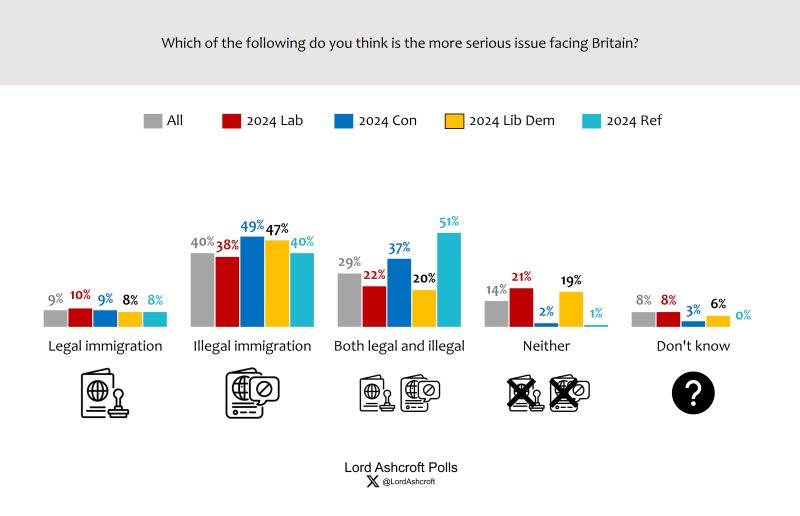 Voters as a whole thought illegal migration into Britain was a more serious issue than legal migration, even though the number of legal migrants was much higher. 2024 Conservative, Labour and Lib Dem voters were more likely to say illegal migration was more serious than that both were equally serious, while Reform voters were more likely to say they were equally serious. Fewer than one in ten said the volume of legal migration into Britain was a more serious issue than illegal migration. Just over one in five 2024 Labour voters and 41 per cent of 2024 Green voters said neither was an important issue.
Voters as a whole thought illegal migration into Britain was a more serious issue than legal migration, even though the number of legal migrants was much higher. 2024 Conservative, Labour and Lib Dem voters were more likely to say illegal migration was more serious than that both were equally serious, while Reform voters were more likely to say they were equally serious. Fewer than one in ten said the volume of legal migration into Britain was a more serious issue than illegal migration. Just over one in five 2024 Labour voters and 41 per cent of 2024 Green voters said neither was an important issue.
The opposition and the next election
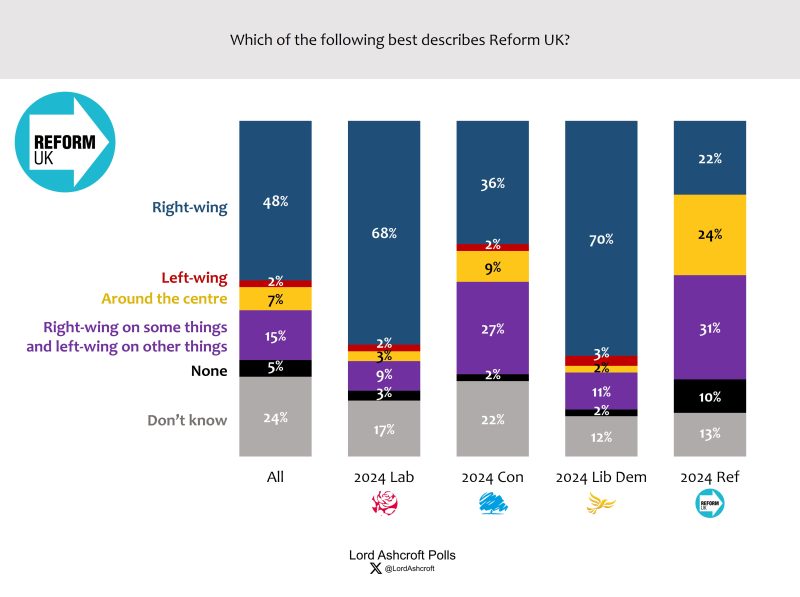 Asked where they would put Reform UK on the political spectrum, just under half of all voters thought “right wing” was the best description of the party. Labour, Lib Dem and Green voters were the most likely to say this. However, Reform voters were the least likely to accept this description (only 22 per cent of them did so). They were much more likely to consider the party right-wing on some things and left-wing on other things or around the centre.
Asked where they would put Reform UK on the political spectrum, just under half of all voters thought “right wing” was the best description of the party. Labour, Lib Dem and Green voters were the most likely to say this. However, Reform voters were the least likely to accept this description (only 22 per cent of them did so). They were much more likely to consider the party right-wing on some things and left-wing on other things or around the centre.
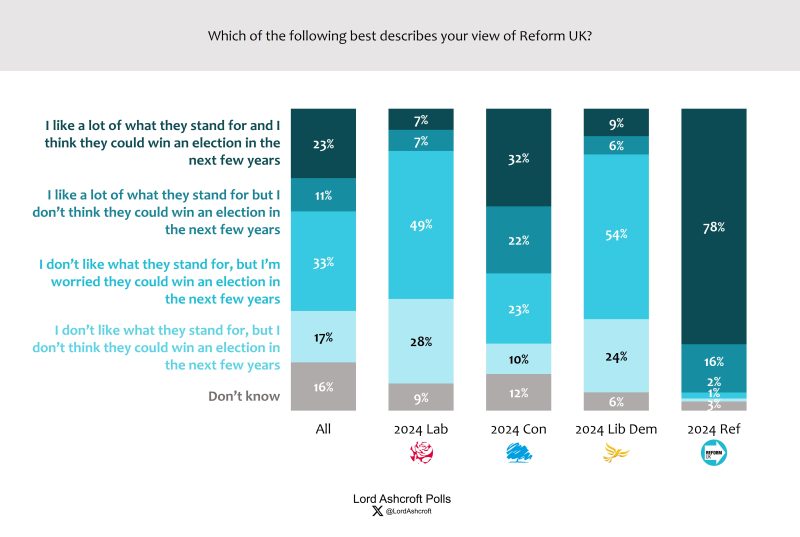
A majority of all voters said they thought Reform could win a general election in the next few years, whether they liked what the party stood for (23 per cent) or not (33 per cent). More voters said they thought could win an election (56 per cent) than that they liked what the party stood for (44 per cent).
Nearly half of 2024 Labour voters said they didn’t like what Reform stood for but were worried the party could win a general election; a further 7 per cent said they liked what Reform stood for and thought the party could win.
More than half of 2024 Conservatives said they liked a lot of what Reform stood for, whether they thought the party could win an election or not. Most also thought Reform could win an election, whether they liked what the party stood for or not.
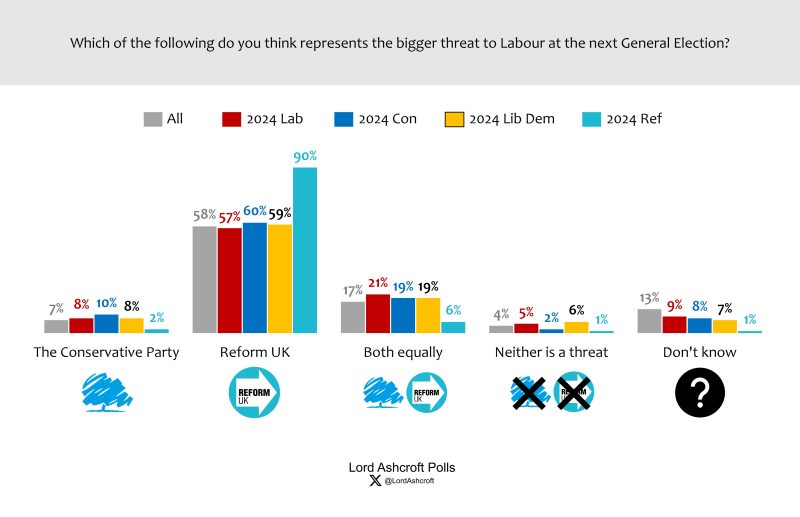 A majority of all voters, including most 2024 Labour voters and 92 per cent of those intending to vote Reform UK, said they thought Reform was a bigger threat to Labour than the Conservatives at the next general election. Only 7 per cent said the Tories were the bigger threat, while 17 per cent thought the two parties were an equal threat to Labour.
A majority of all voters, including most 2024 Labour voters and 92 per cent of those intending to vote Reform UK, said they thought Reform was a bigger threat to Labour than the Conservatives at the next general election. Only 7 per cent said the Tories were the bigger threat, while 17 per cent thought the two parties were an equal threat to Labour.
2024 Conservatives were more likely to think Reform were the bigger threat than the Tories or that the two parties were an equal threat to Labour. Those currently intending to vote Conservative also thought were a bigger threat to Labour than the Tories.
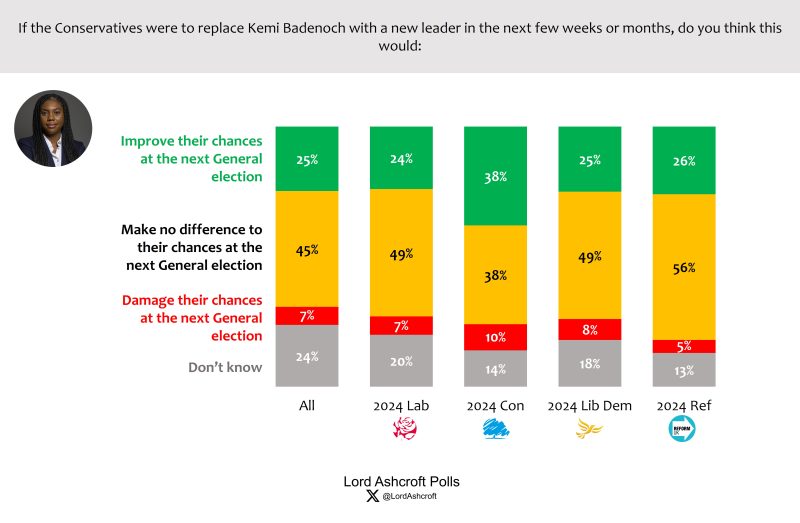
Only a quarter of voters thought replacing Kemi Badenoch as leader would improve the Conservatives’ chances at the next election. A majority said it would either make no difference (45 per cent) or would damage their chances (7 per cent). Those currently intending to vote Conservative were the most likely to say that replacing Badenoch would improve the party’s chances (39 per cent), but they too were more likely to say either that it would damage the party’s chances (12 per cent) or make no difference (35 per cent).
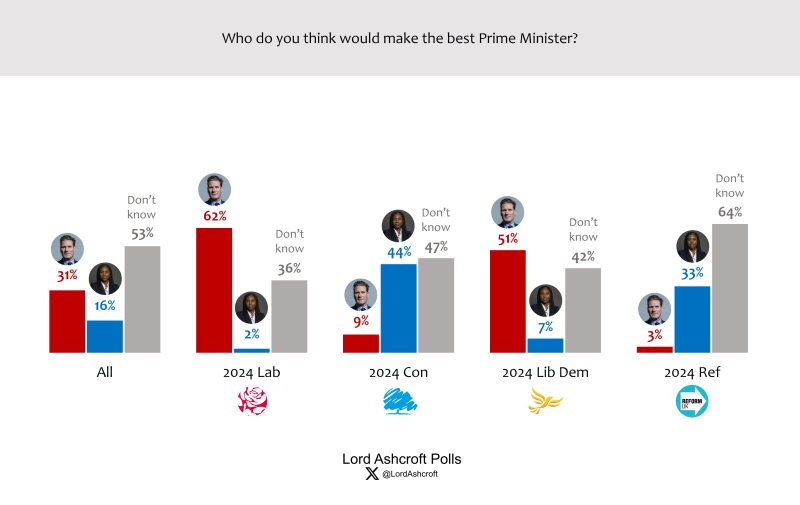 Given a choice between Starmer and Badenoch, voters overall say Starmer would make the best PM by a 15-point margin, though with more than half saying “don’t know”. Sixty-two per cent of 2024 Labour voters say Starmer would make the better PM (down 5 points since last month), while 44 per cent of 2024 Conservatives named Badenoch (up 5 points). Those who voted Reform UK in 2024 said they preferred Badenoch to Starmer by a 30-point margin with nearly two thirds saying “don’t know”.
Given a choice between Starmer and Badenoch, voters overall say Starmer would make the best PM by a 15-point margin, though with more than half saying “don’t know”. Sixty-two per cent of 2024 Labour voters say Starmer would make the better PM (down 5 points since last month), while 44 per cent of 2024 Conservatives named Badenoch (up 5 points). Those who voted Reform UK in 2024 said they preferred Badenoch to Starmer by a 30-point margin with nearly two thirds saying “don’t know”.
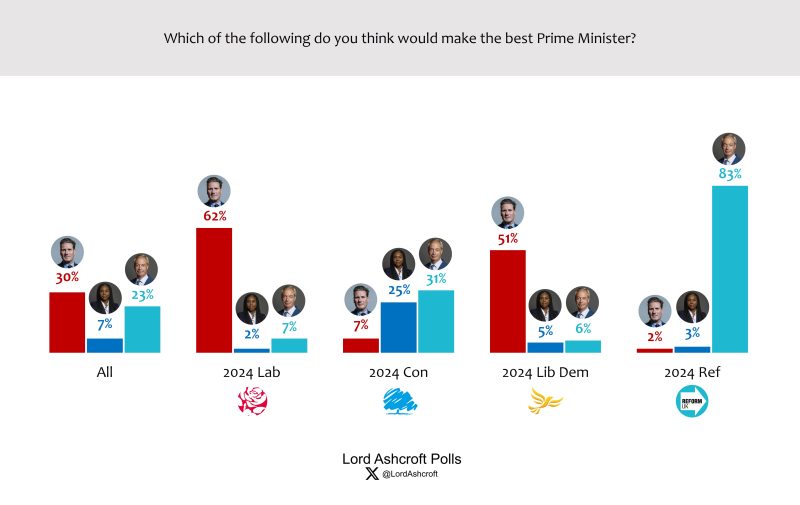 Offered a choice between Starmer, Badenoch and Farage, voters chose Starmer over Farage by a 7-point margin (compared to 13 points last month and 16 points in March), with Badenoch in third place on 7 per cent.
Offered a choice between Starmer, Badenoch and Farage, voters chose Starmer over Farage by a 7-point margin (compared to 13 points last month and 16 points in March), with Badenoch in third place on 7 per cent.
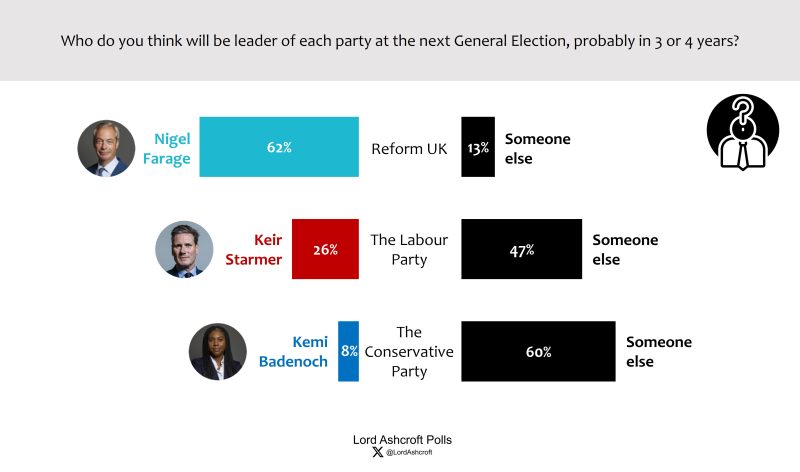 Six in ten thought someone other than Kemi Badenoch would be leading the Conservative Party by the time of the next general election, including nearly two thirds of 2024 Conservative voters. Nearly half expect someone other than Keir Starmer to be leading the Labour Party, including 36 per cent of 2024 Labour voters. However, more than six in ten expect Nigel Farage still to be leading Reform UK, including 8 in 10 of those who voted Reform in 2024.
Six in ten thought someone other than Kemi Badenoch would be leading the Conservative Party by the time of the next general election, including nearly two thirds of 2024 Conservative voters. Nearly half expect someone other than Keir Starmer to be leading the Labour Party, including 36 per cent of 2024 Labour voters. However, more than six in ten expect Nigel Farage still to be leading Reform UK, including 8 in 10 of those who voted Reform in 2024.
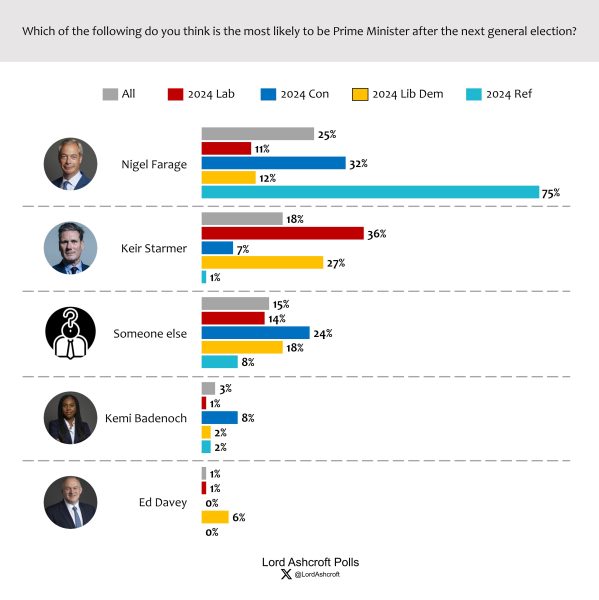
Nigel Farage was thought the most likely of the current party leaders to be prime minister after the next general election, with fewer than one in five naming Keir Starmer and just 3 per cent naming Kemi Badenoch. 2024 Conservatives and Reform UK voters were the most likely to expect Farage to become PM. Just 36 per cent of 2024 Labour voters named Starmer, while more than one in ten named Farage.
Eight in ten of those currently intending to vote for Reform said they expected Farage to be PM after the next election. Eighteen per cent of current Conservatives named Farage, with 15 per cent naming Badenoch. Just over half of those intending to vote Labour said they expected Starmer to be PM after the next election.
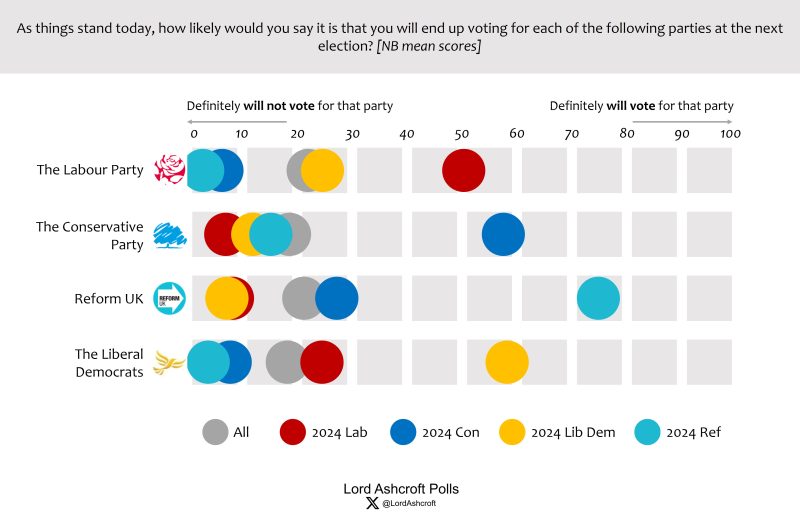 Those who voted Labour in 2024 put their chances of doing so again at the next election at an average of 50/100, down from 58/100 in March. Those who voted Conservative were more likely to repeat their 2024 vote (58/100, down from 68/100 in March). Those who voted Reform UK put their chances of doing so again at 75/100, up from 64/100 in March.
Those who voted Labour in 2024 put their chances of doing so again at the next election at an average of 50/100, down from 58/100 in March. Those who voted Conservative were more likely to repeat their 2024 vote (58/100, down from 68/100 in March). Those who voted Reform UK put their chances of doing so again at 75/100, up from 64/100 in March.
Looking at those more likely than not to vote for a particular party (those whose highest likelihood of voting for one party was at least 50/100), this implies current vote shares of Reform UK 27%, Labour 22%, Conservative 19%, Lib Dem 13%, Greens 13%, Others 6%.
The political map
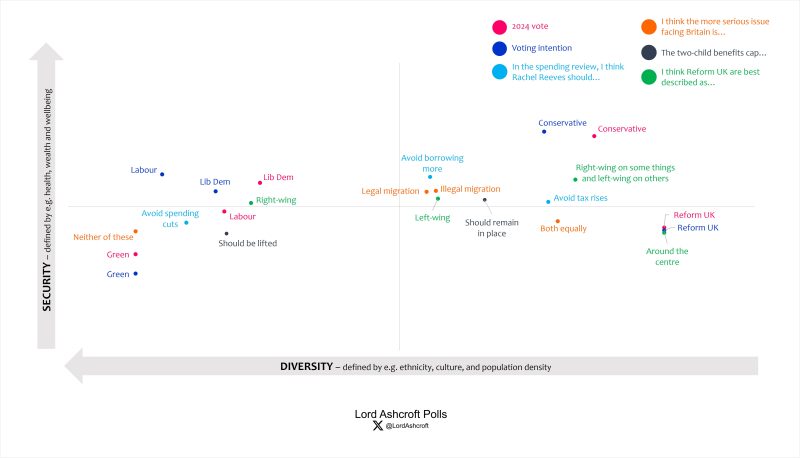
As above, our political map shows how different issues, attributes, personalities and opinions interact with one another.
Each point shows where we are most likely to find people with that characteristic or opinion; the closer the plot points are to each other the more closely related they are. Here we see the close overlap between those most likely to vote for Reform UK and those who see the party as being around the middle of the political spectrum, rather than on the right (as it is most likely to be seen in Labour-Lib Dem territory) or as right-wing on some things and left-wing on others (as it is most likely to be seen in more the prosperous Tory-leaning top right). The top-right quadrant is also where we are most likely to find those who would like the Chancellor to avoid taxing and borrowing more, while the Labour-leaning bottom left is where we are most likely to find those who want to avoid spending cuts, as well as those who would like to lift the two-child benefit cap. This is also where we are most likely to find those who say that neither legal nor illegal migration is a serious issue.
What is driving people?
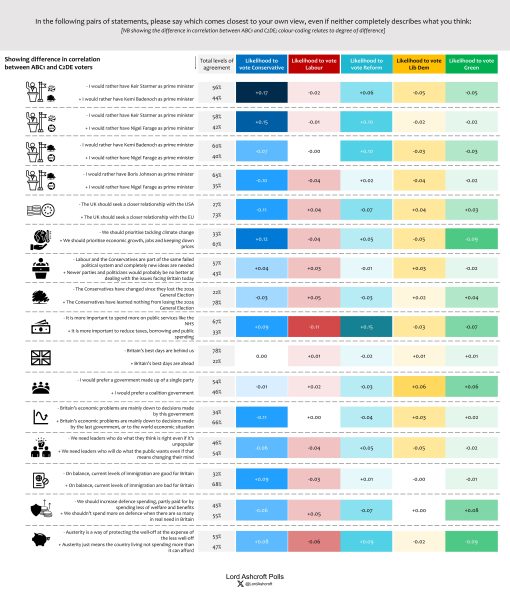 As in previous polls, we have asked a series of “mini referendum” questions to help understand the relationship between people’s opinions on various issues and their likelihood to support different parties. This month we have focused on the social grade difference in these signifiers ahead of the spending review. In terms of prioritising spending increases or tax cuts, voters as a whole favour spending increases by two to one with ABC1 and C2DE voters supporting in similar numbers.
As in previous polls, we have asked a series of “mini referendum” questions to help understand the relationship between people’s opinions on various issues and their likelihood to support different parties. This month we have focused on the social grade difference in these signifiers ahead of the spending review. In terms of prioritising spending increases or tax cuts, voters as a whole favour spending increases by two to one with ABC1 and C2DE voters supporting in similar numbers.
Preferring tax cuts is closely correlated with support for Reform or the Tories, prioritising spending increases with a likelihood to vote Labour, Lib Dem or Green. Inside this general pattern, the preferences of middle-class voters for tax cuts or spending increases are even more significantly aligned with their preferred political party than is true among working class voters.
This pattern is repeated when we ask people whether austerity is necessary or just a means to protect the rich at the expense of the poor. The country as a whole is fairly evenly split, with slightly more people against austerity than in favour of it. As might be expected, the consistent divide between Reform and the Conservatives on the one hand and Labour, Lib Dems and the Greens on the other is maintained but so is the fact that the alignment between people’s views of austerity and party preference is stronger among middle class voters than working class ones.
On whether to prioritise tackling climate change or economic growth, twice as many voters opt for growth over tackling climate change than the other way round. Prioritising growth over climate action is a more potent signifier of the likelihood to support the Tories among middle class voters than working class ones.
The other most significant social grade-based differences relate mainly to issues of leadership and the impact they have on the likelihood to vote Conservative or Reform. Antipathy towards Keir Starmer as prime minister is a more important signifier of support for the Tories or Reform among middle class voters than it is among working class voters, the main difference between these two groups being whether people prefer Farage or not as the alternative. A preference for Farage over Badenoch is the strongest signifier of support for Reform (and a stronger signal among middle class voters).
It is also worth noting that the single most powerful signifier of support for the Conservatives is whether or not someone thinks the party has changed since its general election defeat. As our focus groups show, given that the succession of leaders was part of the Tories’ problem, another early leadership election would undermine attempts to show that the party had in fact changed.
Full data tables at LordAshcroftPolls.co
The post Lord Ashcroft: My latest polling: U-turns on migration and winter fuel, the two child Benefit Cap, and what will Rachel do? appeared first on Conservative Home.



![Former Bravo Star Charged After Violent Assault Using a Rock-Filled Sock in Tennessee Walmart [WATCH]](https://www.right2024.com/wp-content/uploads/2025/07/Former-Bravo-Star-Charged-After-Violent-Assault-Using-a-Rock-Filled-350x250.jpg)



![Illegal Alien Walked Free After Decapitating Woman, Abusing Corpse for Weeks [WATCH]](https://www.right2024.com/wp-content/uploads/2025/07/1753013138_Illegal-Alien-Walked-Free-After-Decapitating-Woman-Abusing-Corpse-for-350x250.jpg)
![NYC Man Snatches Child Off The Sidewalk, Parents Chase Him Down [WATCH]](https://www.right2024.com/wp-content/uploads/2025/07/NYC-Man-Snatches-Child-Off-The-Sidewalk-Parents-Chase-Him-350x250.jpg)
![Man Arrested After Screaming at Senators During Big Beautiful Bill Debate [WATCH]](https://www.right2024.com/wp-content/uploads/2025/06/Man-Arrested-After-Screaming-at-Senators-During-Big-Beautiful-Bill-350x250.jpg)
![Karoline Leavitt Levels CNN's Kaitlan Collins and Other Legacy Media Reporters [WATCH]](https://www.right2024.com/wp-content/uploads/2025/07/Karoline-Leavitt-Levels-CNNs-Kaitlan-Collins-and-Other-Legacy-Media-350x250.jpg)

